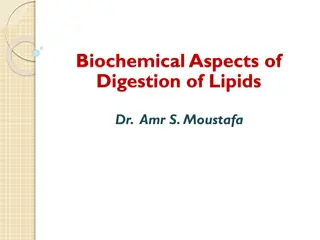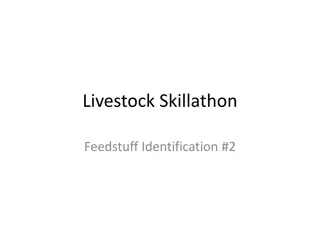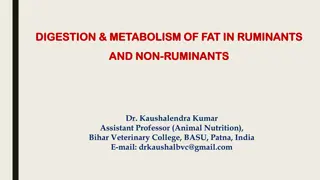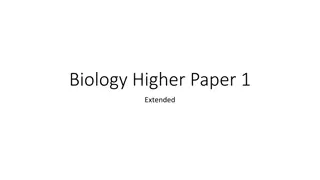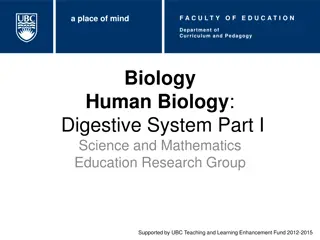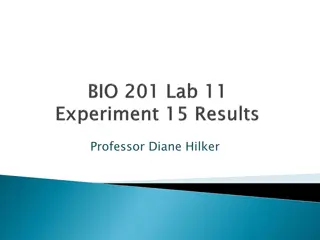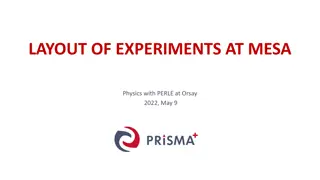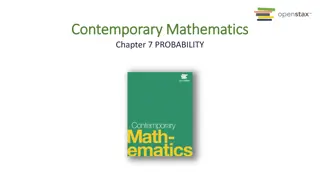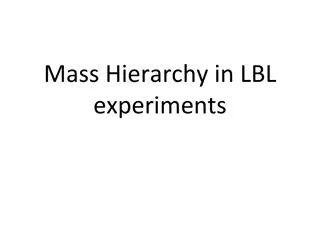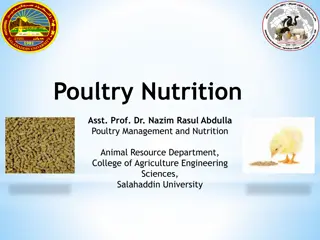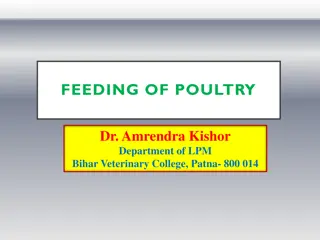Evaluation of feedstuffs by digestion experiments
The evaluation of feedstuffs through digestion experiments, including physical, chemical, and biological evaluations. It also discusses the measurement of digestibility and the different methods used for determining digestibility coefficients.
- feedstuff evaluation
- digestion experiments
- physical evaluation
- chemical evaluation
- biological evaluation
- digestibility measurement
- digestibility coefficient
- feedstuff analysis
Download Presentation

Please find below an Image/Link to download the presentation.
The content on the website is provided AS IS for your information and personal use only. It may not be sold, licensed, or shared on other websites without obtaining consent from the author. Download presentation by click this link. If you encounter any issues during the download, it is possible that the publisher has removed the file from their server.
E N D
Presentation Transcript
Evaluation of feedstuffs by digestion experiments Lecture 1. Dr. Muneendra Kumar Assistant Professor Department of Animal Nutrition muneendra82@gmail.com COLLEGE OF VETERINARY SCIENCE & ANIMAL HUSBANDRY U.P. PT. DEEN DAYAL UPADHYAYA PASHU CHIKITSA VIGYAN VISHWAVIDYALAYA EVAM GO-ANUSANDHAN SANSTHAN (DUVASU), MATHURA - 281001 (U.P.) www.upvetuniv.edu.in 1
Evaluation of feeds and feed ingredients for quality The feeds are usually subject to the following types of tests: 1. Physical evaluation: Colour, size, homogeneity, smell, taste, touch, sound, etc. 2. Chemical evaluation: Proximate analysis, detergent method, mineral and vitamin analysis 3. Biological evaluation: Digestibility determination Dr. Muneendra Kumar, Assistant Professor, Department of Animal Nutrition, DUVASU, Mathura 2
Measurement of digestibility The digestibility of a food is most accurately defined as the proportion that is not excreted in the faeces and that is, therefore, assumed to be absorbed by the animal. It is commonly expressed in terms of dry matter (DM) and as a coefficient or a percentage (%). Digestibility coefficients (DC) can be calculated in the same way for each constituent of the DM. Dr. Muneendra Kumar, Assistant Professor, Department of Animal Nutrition, DUVASU, Mathura 3
Digestibility Coefficient (%)/Apparent digestibility Amount of the nutrient intake Amount of nutrient voided in faeces = ---------------------------------------------------------------------------------- 100 Amount of the nutrient intake For example, if a cow eat 9 kg of hay containing 8 kg of DM and excreted 3 kg of DM in its faeces, the digestibility of the DM would be: 8 3/ 8 x 100 = 62.5% Dr. Muneendra Kumar, Assistant Professor, Department of Animal Nutrition, DUVASU, Mathura 4
The digestibility coefficient determined is apparent since the faeces contain metabolic (abraded mucosa, unspent enzymes and undigested microbes) as well as undigested feed component. (Amount of nutrient consumed - (total nutrient faecal excretion metabolic losses) True digestibility (%) = ----------------------------------------------------------------------- 100 Amount of nutrient consumed Apparent digestibility < true digestibility The digestibility of ingested carbohydrates is overestimated The digestibility of ash or minerals is not estimated Dr. Muneendra Kumar, Assistant Professor, Department of Animal Nutrition, DUVASU, Mathura 5
Digestibility Determination Methods Direct method Difference method In vivo method Indirect method Indicators/markers method Methods In sacco/semi in vivo/in situ/nylon bag method In vitro method Dr. Muneendra Kumar, Assistant Professor, Department of Animal Nutrition, DUVASU, Mathura 6
Lecture 2. 1. In Vivo Digestibility Determination Methods Digestion trial Metabolism trial A digestion trial involves a record of the nutrients consumed and of the nutrients voided in faeces Ametabolism trial involves a record of the nutrients consumed and of the nutrients voided in faeces, urine, milk, etc. Used to determine the balance of nutrient Requires collection of feed intake, faeces, urine voided e.g. balance of nitrogen and minerals Used to determine the utilization of feedstuff Requires collection of feed intake and faeces voided e.g. utilization of different feedstuffs Dr. Muneendra Kumar, Assistant Professor, Department of Animal Nutrition, DUVASU, Mathura 7
Digestion trial Metabolism trial Nutrient balance =Intake (Faecal+urine+milk outgo) 100 Intake CP, CF, EE, Mineral, etc. Total Intake Conc. Fodder DM, CP, CF, EE, Mineral, etc. CP, CF, EE, Mineral, etc. DM, CP, CF, EE, Mineral, etc. DM, CP, CF, EE, Mineral, etc. Nutrient digestibility =Intake Faecal outgo 100 Intake 8
Norms adopted for conducting digestion and metabolism trial A. Selection of animals: 1. The animals should be of the same breed, sex, age and body weight. 2. Generally a minimum of four animals are needed. 3.Animals should be healthy and free from parasites. 4. Male animals are preferred over females because it is easier to collect faeces and urine separately in male animals. 5. Stage of selection of animal depends on the basis of relevance of treatment. Dr. Muneendra Kumar, Assistant Professor, Department of Animal Nutrition, DUVASU, Mathura 9
B. Grouping of selected animals: ??.?? ?????? = ? + 1; n= no. of treatment, 1=control e.g. To study the effect of berseem and maize fodder on growth performance Animal no. 1 2 3 4 5 6 Average/mean Control group Berseem group Maize group 60 69 72 83 64 81 66 63 81 86 64 69 74 89 59 75 63 69 71.5 (kg) 71.5 (kg) 71.5 (kg) Targeted animal may be growing, lactating, pregnant, egg producing, etc. Dr. Muneendra Kumar, Assistant Professor, Department of Animal Nutrition, DUVASU, Mathura 10
Lecture 3. C. Preliminary period: 1. The test feed has to be fed daily in constant amounts, as per the requirements of the animal, for an extended period. This is called preliminary period. 2. The purpose is to make the gastrointestinal tract free of any indigestible material from the feed consumed prior to the start of the digestion trial. 3. In monogastric animals, digestion and evacuation are usually complete in 24 hours after the test feed is ingested. So preliminary period of 2 - 3 days is considered in mono gastric animals. 4. In ruminants, the last residues may be voided in 6 to 8 days. So preliminary period of 7-14 days is considered in ruminants. 5. Water and salt licks are provided at all times. 6. Animals are fed individually. Dr. Muneendra Kumar, Assistant Professor, Department of Animal Nutrition, DUVASU, Mathura 11
D. Collection Period: 1. Animals are transferred to cages or stalls and a 2 - 3 day adaptation period is allowed for their acclimatization. This follows collection period of 5-7 days duration. The longer the period of collection the more accurate the results are, provided the stated amount of feed continues to be consumed regularly and completely, since the effect of periodic fluctuations is minimized. Quantitative collection of faeces, urine, milk, etc. are done. Representative samples of feed offered, feed leftovers and faeces, urine and milk voided are preserved and analyzed for nutrient composition. 2. 3. 4. 5. Dr. Muneendra Kumar, Assistant Professor, Department of Animal Nutrition, DUVASU, Mathura 12
Test Feed 1. The test feed should not be deficient in the nutrients because a deficiency of some of them may affect digestion process. 2. The test feed should be fed at the level required for meeting the requirements of the animals. 3. Normally 90% of the actual feed intake, as measured during the previous week, is offered. 4. Direct determination of digestibility of individual feed may be done if it provides a satisfactory ration for the test period when fed alone. Dr. Muneendra Kumar, Assistant Professor, Department of Animal Nutrition, DUVASU, Mathura 13
Some feeds cannot be fed alone as they do not supply the bulk and therefore their digestibility coefficients cannot be determined directly. e.g. Oilcakes, cereal grains, concentrate mixtures. Similarly, non-maintenance type of roughages like straw, stovers, dried grasses, etc. do not supply the required amounts of nutrients and so they cannot be fed alone to the experimental animals. In this case, digestibility is measured by indirect methods. Dr. Muneendra Kumar, Assistant Professor, Department of Animal Nutrition, DUVASU, Mathura 14
i. By difference methods For digestibility determination of nutrients in a concentrate like maize grain or groundnut cake, two digestibility trials in a sequence are conducted. For digestibility determination of nutrients in a poor quality roughage like straw, stover, etc., three digestibility trials in a sequence are conducted. 15
Digestibility determination of concentrate 1stdigestion trial Feed the animals with a maintenance type fodder like maize fodder to determine the digestibility of nutrients in it. 2nddigestion trial The same animals are fed the same maintenance type fodder (maize fodder as in 1stdigestion trial) along with known quantity of concentrate (like groundnut cake or maize grain etc.) whose digestibility is to be estimated by difference. Digestibility of nutrients in test feed (concentrate) is calculated by difference on the assumption that nutrients in the original basal roughage (maize fodder) has the same digestibility. Concentrate digestibility = digestion trial 2- digestion trial 1 16
Digestibility determination of poor quality roughage 1stdigestion trial the digestibility of nutrients in it. Feed the animals with a maintenance type fodder like maize fodder to determine 2nddigestion trial The same animals are fed the same maintenance type fodder (maize fodder as in 1st digestion trial) along with known quantity of poor quality roughage (like wheat and paddy straw, etc.) whose digestibility is to be estimated by difference. 3rddigestion trial The same animals are fed poor quality roughage (like wheat and paddy straw, etc.) along with cake feed. Digestibility of nutrients in test feed (poor quality roughage) is calculated by difference on the assumption that nutrients in the original basal roughage (maize fodder) has the same digestibility. Poor roughage digestibility = digestion trial 2- digestion trial 1 Associative effect of feed = digestion trial 2- digestion trial 3 17
Digestibility determination in poultry Digestibility determination is complicated in poultry since faeces and urine excreted from a single opening i.e. cloaca. Therefore, metabolism trial is conducted instead of digestion trial. There are two ways by which digestibility of nutrient can be determined in poultry; 1) Surgical means where separate opening for faeces and urine is created, 2) Chemical means where faecal and urinary nitrogen can be separated. 18
Lecture 4. ii. Indicator/marker method of digestibility determination The conduction of digestion and metabolism trial is a laborious and time consuming procedure. If metabolism cages and other facilities for direct collection of feces and urine voided are not available. If animals are fed in groups, then it is impossible to record the feed consumed and feces voided by each animal in the group. To know intake of herbage from cultivated or natural pastures and digestibility of nutrients in the pasture consumed by the animal is not possible by in vivo method. 19
The ideal specification of an indicator/marker 1. It should be totally indigestible and unabsorbable. 2. It should not have any pharmacological action on the digestive tract. It should be inert to the digestive system. 3. It must mix intimately and remain uniformly distributed in the digesta. 4. It should pass through the tract at a uniform rate and should be voided entirely. 5. It can readily be determined chemically, and 6. Preferably be a natural constituent of the feed under test. 20
Classification Internal/natural marker Lignin, silica, AIA Indicator/ Marker External marker Chromic sequioxide (chromic oxide or Cr2O3), magnesium ferrite, carmine red, Radioactive isotopes- Cr-EDTA, cerium (Ce), ytterbium (Yb), samarium (Sm) Internal indicators can easily be determined. Chromic oxide is the most commonly used marker in monogastric animals. 21
Calculation The digestibility of a nutrient is calculated by estimating the concentration of the indicator in feed and faces and that of the nutrient in the feed and faeces. There is no need to collect faeces and record feed consumption. Assumption is that reference material is uniformly excreted during 24 h % indicator in feed % indicator in faeces % nutrient in the faeces % nutrient in the feed) DC of a nutrient = 100 (100 22
Diurnal variation has been reported and around 94% of indicator is recovered during 24 h DC of a nutrient = 100 (100 % recovery of indicator x % indicator in feed % nutrient in the faeces % nutrient in the feed) % indicator in faeces 23
DigestibilitydeterminationandpastureconsumptioningrazinganimalsDigestibilitydeterminationandpastureconsumptioningrazinganimals It is essential to know the quantity and digestibility of forage a grazing animal consumes. Pasture grasses were harvested and digestion trial was conducted. This method is not correct because grazing animal has a tendency of selective grazing. It is difficult to obtain the representative sample of forage actually eaten by the grazing animal and quantitative collection of faeces. Marker method can be used for determination of digestibility as well as intake of pasture in grazing animal. 24
Internal indicator used for digestibility determination while external indicator used for faecal output measurement. Marker consumed (g/d) Faecal DM output = ---------------------------------------------------------------- Marker concentration in faeces (g/g DM) 100 DM intake = Faecal DM output ----------------------------------- % indigestibility of DM 25
e.g. A grazing animal was fed 2 g of Cr2O3in a capsule per day. Find out the Forage intake and its DM digestibility. The data is as follows % composition DM Lignin (Internal Indicator) Cr2O3 (External Indicator) Forage 20 0.05 - Faeces 15 0.10 0.1 26
Daily dry matter voided in faeces (g/day) Amount of Cr2O3fed daily = ------------------------------------------- = --------- = 2000 g g of Cr2O3per g of faeces 2 0.001 0.05 15 DM dige.coe.of forage = 100 - { 100 x ----------- x -------- } 0.10 20 = 100 -37.5 = 62.5% 27
DM voided DM intake = ------------------------------- x 100 % of DM indigestibility 2000 = --------- x 100 = 5333 g 37.5 5333 Fresh forage intake = ---------- x 100 20 = 26665 g/day = 26.665 kg/day. 28
Advantages No need to measure feed intake. No need to collect faecal output. Quantify rate of passage and extent of digestion in different segments of the gut. 29
Limitation of in vivo method Minimum 4 animals are required. Large quantity of feed, daily recording of intake and outgo are required. Require metabolic cage or stall. Method is costly and laborious. 30
Lecture 6. In sacco/semi in vivo/in situ/nylon bag method In this method, digestibility of test feedstuff is determined by keeping the feed sample in bags which are placed in rumen contents of rumen fistulated animals. The used bag is made up of nylon, dacron or silk material which is indigestible by rumen microbes. The bag should be of very fine porosity so that the test feed particles should not comes out from the bag but at the same time it should allow the rumen microbes to enter into the bag and act on the test feed. The rumen incubated bags are removed at different time intervals, washed and dried at 60 C for 48 hrs. The percent loss of DM and other nutrients are determined. 31
9 cm 14 cm Nylon bag 32
1. Very useful technique for initial evaluation of feedstuffs and is useful in rapid screening of large number of samples involved in forage breeding experiments. 2. Technique is helpful in understanding the rumen process ether by varying the rumen environment or factors within the bag. 3. The % of material degraded (p) after time (t) hours can be determined by the equation: p= a + b (1-e-ct) The effective rumen degradability (P) of the protein can the be calculated by the equation: 35
The test feed in the bag is not subjected to the total ruminal experience like mastication, rumination and passage. Some amount of feed sample which is small enough to leave the bag and not necessarily digested by rumen microbes. 36
Factors affecting in sacco digestibility 1. Particle size of the test feed sample The optimum test feed particle size should be 1-2 mm. Longer and coarse particle size is associated with slower rate of digestion therefore more variation in digestibility. Finely grounded material are associated with the more mechanical losses from the bags. 2. Bag porosity Appropriate bag porosity (40-60 m) is mandatory to limit the influx of rumen feed particles and efflux of feed particles from bag. However it allow the influx of rumen microbes to degrade the test feed. 37
The optimum sample size is that which provides enough residues at the end of extended rumen incubation for chemical analysis. Over filling the bag delay bacterial attachment and under estimate digestibility. The amount of sample taken is depends upon the bulk density of sample. For bag having dimension 14 x 9 cm, it is recommended about 2 g straw, 5 g concentrate, 10-15 g green roughage. 38
A range of 10-20 mg/cm2 of sample size to bag surface area ratio should be the criteria for most of the feedstuffs. Other factors which affects digestibility in in sacco methods are: 1. Diet of the animal 2. Bag per animal per incubation time 3. Position of the bag in rumen 4. Incubation length 5. Timing of introduction in rumen 39
The incubation times may be 3, 6, 9, 12, 18, 24, 48, 72, 120 hours which are to be chosen depending on type of the test feed sample and the nutrient under study. At each incubation interval measurements are to be done in triplicate bags. 40
Lecture 7. In Vitro digestibility determination method The in vitro dry matter digestibility (IVDMD) method has been extensively used to evaluate the nutritional value of ruminant feeds. The method is easier than in vivo analysis and avoids the need to surgically prepared animals in different locations in the gastro-intestinal tract. This method used for rapid screening of large number of samples in forage experiments. This method is also useful in evaluation of newer feedstuffs such as NCFR. 41
Types of in vitro method 1. One stage technique The principle of this method is that rumen microbial digestion of animal is simulated in laboratory where feed sample is incubated with rumen liquor at 39 degree celsius under anaerobic condition in a artificial rumen. This method require test feed sample, artificial saliva, and the rumen inoculum. The content is placed in anaerobic condition at 39 degree celsius for a specific period. After incubation, samples are removed and disappearance of DM or OM is determined. 45
2. Two stage technique First stage simulates the digestive process in the rumen. The residue left after first stage is further treated with either pepsin solution (Tilley and Terry, 1963) or with NDS (Van Soest el al., 1966). Acid pepsin digestion stage simulates the in vivo breakdown of feed and microbial protein by the digestive enzymes of the lower gut. However, 2ndsecond stage procedure with NDS estimates the true digestibility instead of apparent digestibility of feed because NDS solubilises bacterial cell wall and other endogenous products. 46
In vivo artificial rumen (VIVAR) The VIVAR tube is made up of stainless steel or glass and fitted with semi-permeable membranes. Rumen microbes cross through semi permeable membrane and degrade feed sample present inside the VIVAR tube but the sample particles can not move outside. After completion of the fermentation period, VIVAR tube is removed and DM disappearance is recorded. 47
A. Animal factors 1. Species of animal 2. Age of animal 3. Work and exercise 4. Individuality 5. Level of feeding FACTORS AFFECTING DIGESTIBILITY B. Plant factors 1. Protein content 2. Carbohydrate content 3. Lipid content 4. Mineral level C. Feed preparation 1. Particle size 2. Soaking 3. Boiling, micronizing, pelleting, extrusion, etc 48
Dr. Muneendra Kumar, Assistant Professor, Department of Animal Nutrition, DUVASU, Mathura 49




